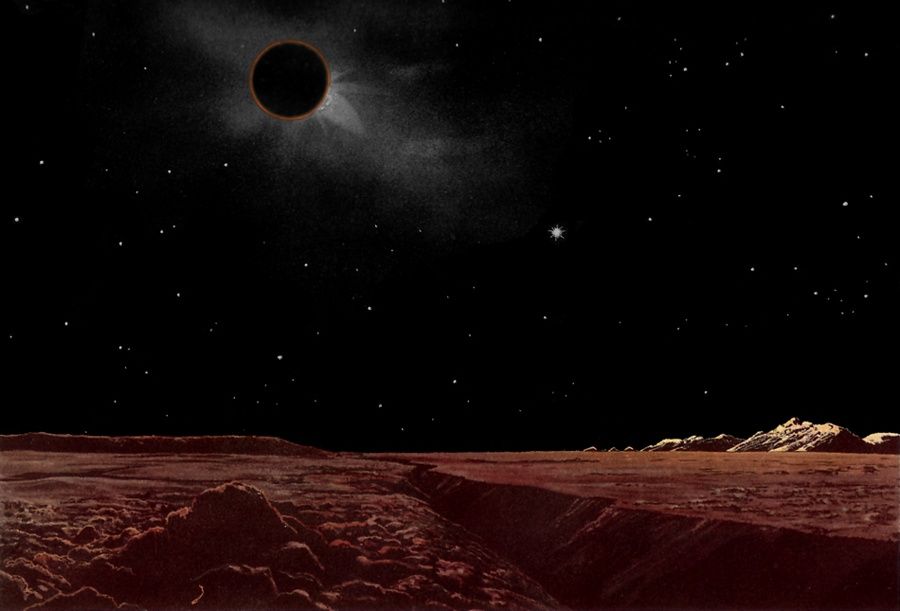
Randall Andrews
Terran Eclipse
I study the
Cool, blue curves of
The lost world—my grandfather’s
Land—where lie buried the roots of my
Race. I watch and wonder about thunderstorms
And locust swarms and tiger stripes. I fantasize
About azure skies, green fields and amber sands,
Nostalgic for a place I never knew. I track the
Planet’s path across the stars, measuring the
Moments as it closes on its quarry. Ninety
Million miles separate the spheres,
Yet they come together.
Alignment nears.
I shudder
When the shadow
Descends, darkening the
Day, stealing the sun from the
Sky. The weight of the shade of
The earth presses down, heavy on
My heart and in my mind—as I
Dream of the days when my
Ancestor’s gaze was fixed
Here on my home
On the moon.
____________
Randall Andrews is the author of two books, Finding Hour Way and The Last Guardian of Magic, which won the National Indie Excellence Award. His short stories and poems have appeared in places like Abyss & Apex, Space & Time, Star*Line, Flash Fiction Magazine, Every Day Fiction, Blind Corner, 365 Tomorrows, Red Planet, and more. When not writing, he can be found wearing the soles off a pair of running shoes, listening to his favorite John Williams soundtracks, or hand-feeding his loyal flock of wild songbirds.
Author’s Backstory: On a sunny afternoon in the summer of 2020, I sat along the bank of the Maumee River turning the pages of a Terry Brooks novel and studying the faint silhouette of a daylight moon. I’ve often imagined how amazing it would be to visit Earth’s lone satellite, but that day I found myself wondering instead what sort of permanent residence it would make. Not so amazing, I suspect. That train of thought collided later in the day with an article I read about eclipses, and the two things merged into a poem. Over the course of the following year, I set “Terran Eclipse” down repeatedly, but kept picking it up again until I was finally able to coax it into its current form.
Editor’s Note: When I teach astronomy, pictures showing geometry truly replace a thousand words that can spin your head, yet I don’t want to wax too scientific so I’ll try to be concise.
When the Moon, Earth, and Sun line up, a lunar eclipse as viewed from Earth occurs since the Moon will be full, and as Earth passes between the Moon and the Sun, Earth’s shadow slips over to just cover the entire Moon because the apparent size of the Moon and the Sun are the same [0.5 degree]. This is the situation represented in the poem: When the shadow/Descends, darkening the/Day, stealing the sun from the/Sky… Here on my home/On the moon. Lucien Rudaux painting shows this.
However, when the line-up is Earth, Moon, and Sun, then the Moon will be backlit and appear as a new moon, so as the Moon passes between Earth and the Sun, it could totally eclipse the sun and display those minutes-long masterpieces of the sun’s corona bedazzling the darkening skies; however, if viewed from the Moon, its shadow cast on Earth will be much smaller and not cover our globe completely because of the much smaller subtended angle of the Sun; also it won’t be red because there is no atmosphere on the Moon to scatter the light [Rayleigh scattering is responsible for our warm-colored sunsets and sunrises].
See “What Would the Solar Eclipse [as we call it on Earth] Look Like From the Moon?” by Marina Koren [The Atlantic, Aug 2017]. https://www.theatlantic.com/science/archive/2017/08/solar-eclipse-from-the-moon/537339/ Also see Chris Butler’s Science Photo library showing this: “Artwork showing the shadow of the Moon (upper center left) projected onto the Earth during a total solar eclipse.” https://www.sciencephoto.com/media/328690/view/earth-seen-from-the-moon-during-a-solar-eclipsehim
Image Credit: A painting by Lucien Rudaux shows how a sun is eclipsed from the lunar surface. Lucien Rudaux (1874–1947) was a French artist and astronomer, who created famous paintings of space themes in the 1920s and 1930s. https://en.wikipedia.org/wiki/Lucien_Rudaux

Compliments to Mr. Andrew’s. Good poem.